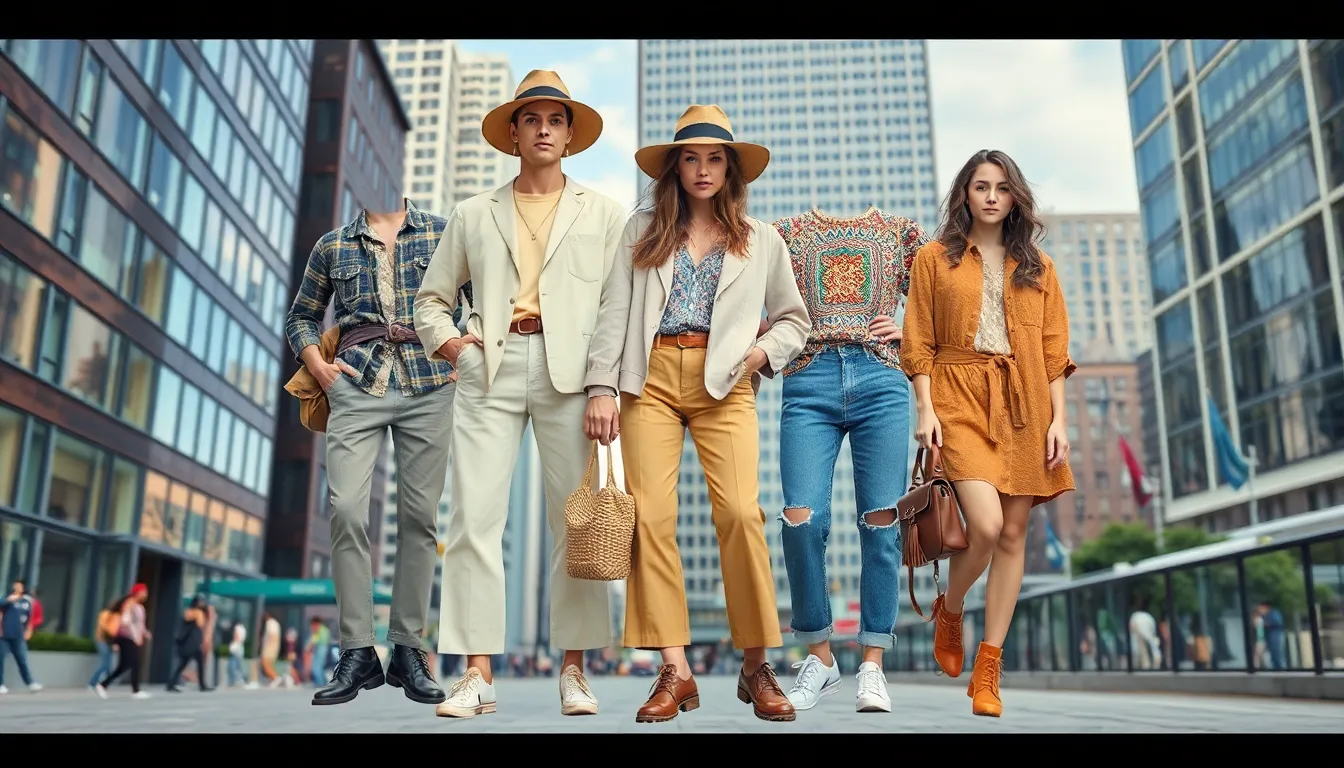In a world increasingly aware of environmental issues, sustainable fashion has emerged as a beacon of hope. This movement champions ethical practices and eco-friendly materials, reshaping how people perceive style and consumption. As consumers seek to make mindful choices, a sustainable fashion magazine becomes an essential resource for navigating this evolving landscape.
By showcasing innovative designers, sustainable brands, and conscious lifestyle tips, these publications inspire readers to embrace a wardrobe that reflects their values. They not only highlight the beauty of eco-conscious fashion but also educate on the importance of reducing waste and supporting ethical production. In this article, we’ll explore the impact and significance of sustainable fashion magazines in promoting a greener future for the industry and its followers.
Table of Contents
ToggleOverview of Sustainable Fashion Magazines
Sustainable fashion magazines serve as essential platforms that educate consumers on eco-friendly fashion choices and ethical practices. They highlight the intersection of style and sustainability, offering valuable insights into the industry.
What Is Sustainable Fashion?
Sustainable fashion refers to clothing and accessories produced in environmentally friendly ways. It focuses on sustainable materials like organic cotton or recycled fibers. It promotes ethical labor practices, ensuring fair wages and safe working conditions for garment workers. Brands define their commitment to sustainability through transparency and responsible consumption.
Importance of Sustainability in Fashion
Sustainability in fashion addresses pressing global issues such as climate change and waste management. It reduces harmful environmental impacts by minimizing resource consumption and pollution. Sustainable practices foster innovation, pushing brands to adopt circular production models, where materials are reused or recycled. Additionally, sustainable fashion encourages consumers to invest in quality items, leading to reduced overconsumption and waste in landfills.
Notable Sustainable Fashion Magazines

Sustainable fashion magazines play a crucial role in educating consumers and promoting eco-friendly practices within the fashion industry. They highlight key trends, innovative designers, and ethical brands committed to sustainability.
Key Publications to Follow
- Elle Sustainable
Elle Sustainable focuses on eco-conscious fashion, featuring brands that prioritize sustainability. It provides insights into the latest trends and advice for adopting a greener wardrobe.
- Vogue Sustainability
Vogue’s Sustainability section explores luxury fashion’s responsibility to the environment. It covers impactful stories, interviews with designers, and showcases collections reflective of sustainable practices.
- Eco-Age
Eco-Age promotes brands committed to sustainability and transparency. Known for its Green Carpet Challenge, it highlights sustainable fashion events and advocates for ethical practices.
- The Good Trade
The Good Trade delivers content centering on sustainable living, including fashion, beauty, and lifestyle. It offers guides and product recommendations, helping consumers make informed choices.
- Sustainable Fashion Forum
Sustainable Fashion Forum highlights discussions around sustainable practices, offering a platform for industry leaders to share insights. It also promotes educational resources and events related to sustainable fashion.
Unique Features and Approaches
- Educational Content
Sustainable fashion magazines provide deep dives into materials, production methods, and industry challenges. They educate readers on the environmental impact of fashion choices and promote mindful consumption.
- Spotlighting Innovations
These publications often spotlight innovative designs and brands using recycled materials or ethical production methods. They illustrate how fashion can evolve while reducing its carbon footprint.
- Interview Series
Interviews with industry leaders, eco-conscious designers, and sustainability advocates allow readers to understand various perspectives on fashion sustainability and its future.
- Community Engagement
Sustainable fashion magazines engage readers through newsletters and social media, promoting discussion around sustainable practices and encouraging lifestyle changes.
- Eco-Friendly Guides
Many magazines develop actionable guides on building a sustainable wardrobe, including tips on thrifting, investing in quality pieces, and understanding certifications.
Impact on Fashion Industry
Sustainable fashion magazines significantly influence the fashion industry by promoting ethical practices and shaping consumer behavior. Their role extends beyond mere information dissemination to actively fostering a culture of sustainability within fashion.
Promoting Ethical Practices
Sustainable fashion magazines champion ethical practices by spotlighting brands that prioritize fair labor conditions and responsible sourcing. They provide in-depth analyses of production methods, emphasizing transparency in supply chains. By featuring designers who adhere to ethical standards, these magazines encourage consumers to support companies committed to social responsibility. Regular content on certifications, such as Fair Trade and GOTS, helps readers identify genuinely ethical brands and products. This emphasis strengthens the industry’s commitment to improving labor rights and minimizing environmental impact.
Influencing Consumer Behavior
Sustainable fashion magazines significantly shape consumer behavior by educating readers about the environmental and social impacts of their purchasing choices. By offering actionable tips for sustainable living, these publications motivate individuals to adopt mindful consumption habits. Readers learn the value of quality over quantity, leading to the preference for timeless pieces over fast fashion. Through style guides and wardrobe staples discussions, magazines inspire consumers to explore second-hand shopping and clothing swaps, fostering a community centered around sustainability. Collaborations with influencers amplify this message, reaching wider audiences and instilling a desire for conscious fashion choices.
Challenges Faced by Sustainable Fashion Magazines
Sustainable fashion magazines confront multiple challenges that impact their growth and influence in the industry. Key issues include financial viability and maintaining quality content.
Financial Viability
Financial sustainability poses a significant challenge for many sustainable fashion magazines. Limited advertising revenue from eco-friendly brands, which often operate on smaller budgets, constrains available resources. Additionally, increased competition from mainstream publications vying for readers’ attention leads to difficulties in attracting subscribers. Some magazines adapt by exploring diverse revenue streams such as partnerships, crowdfunding efforts, and exclusive membership offerings that align with their mission while ensuring ongoing financial health.
Maintaining Quality Content
Quality content remains crucial for attracting and retaining an audience in sustainable fashion magazines. The demand for in-depth, well-researched articles on sustainability practices requires extensive resources, including skilled writers and editors. Balancing the need for engaging narratives with educational information can strain a magazine’s capacity. To overcome this, many publications collaborate with experts, leverage user-generated content, or implement editorial strategies that prioritize critical themes. This approach helps ensure audiences receive accurate information while reinforcing the magazine’s authority and credibility in the sustainable fashion arena.
Future Trends in Sustainable Fashion Magazines
Sustainable fashion magazines are evolving to stay relevant in a rapidly changing landscape. They adopt innovative approaches to connect with a growing audience committed to eco-conscious living.
Digital vs. Print
Digital formats are gaining traction among sustainable fashion magazines due to their accessibility and lower environmental impact compared to traditional print. Many magazines offer interactive online experiences, allowing readers to engage with multimedia content such as videos, podcasts, and virtual events. Print publications, however, still maintain a strong presence, catering to consumers who appreciate tactile experiences. Hybrid models are emerging, blending both formats to maximize reach and impact. Publications like Eco-Age and Sustainable Fashion Forum illustrate this trend, providing both online content and limited-edition printed issues that emphasize craftsmanship and sustainable production.
Innovations in Content Delivery
Innovative content delivery methods are shaping the way sustainable fashion magazines communicate their messages. Utilization of augmented reality (AR) and virtual reality (VR) offers immersive experiences, allowing readers to visualize sustainable practices in action. Additionally, subscription-based services provide exclusive content to loyal readers, fostering a community around sustainable living. Interactive features, such as quizzes or curated shopping guides, engage audiences while promoting eco-friendly brands. Collaboration with social media platforms enhances visibility, enabling magazines to tap into influencer-driven campaigns that reach broader demographics. A combination of these strategies drives new readership and cultivates a message of sustainability in accessible ways.
Conclusion
Sustainable fashion magazines are pivotal in shaping a more eco-conscious industry. They not only spotlight innovative designers but also educate consumers on making informed choices. By promoting ethical practices and eco-friendly materials, these publications foster a culture of sustainability that resonates with today’s mindful shoppers.
As they adapt to evolving trends and challenges, sustainable fashion magazines continue to inspire and empower individuals to embrace a greener lifestyle. Their commitment to transparency and quality content reinforces their role as trusted resources in the fashion community. The future of fashion relies on these platforms to drive positive change and encourage a shift towards responsible consumption.









